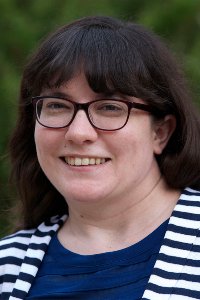Lauren Linderman
LAUREN LINDERMAN came to Minnesota from the University of Illinois at Urbana-Champaign, where she received her PhD degree. Linderman’s research interests include structural dynamics and smart structures technology with an emphasis on wireless sensor technology, vibration mitigation strategies, control algorithm development, vibration-based structural health monitoring (SHM), and experimental testing.
Wireless smart sensors originally gained popularity as a means to monitor the health of structures, that is, technology could send an alert when some problem (cracking or weakening, for example) occurred in a structure. Now, wireless smart sensors can also be used to control structures.
SHM technology can be used to monitor buildings and bridges. Structures can be built with control systems, which is similar to how one might think of shock absorbers in a car. When a building or bridge is being shaken by an earthquake or a strong wind, those “shock absorbers” will lessen the effect. “The
sensors I work on can be used to adjust the control system performance.” Remote monitoring and control of buildings may not result in avoidance of all damage to the building, but should minimize or delay damage and allow people to get out in the event of a structural collapse. When applied to bridges, wireless control systems help control stay cables. In the larger view, sensor and remote monitoring systems should help develop safer, more durable structures.
Linderman’s research on the use of wireless technologies to monitor the health of structures will be of interest to the whole state of Minnesota, where the failing state of our bridges has been a lively topic in the local news since the collapse of the I-35W bridge in 2007. The technologies that Linderman researches help monitor changes in load or movement in structures and, thus, identify potential problems. In the future, Linderman plans to apply wireless smart sensor technology to wind turbines and other energy harvesting systems.
____
"Interdisciplinary studies seem to be a trend for the future—civil engineers may have one area of expertise, but they will also have to develop understanding in related areas in order to carry out complicated tasks that characterize the job of a civil engineer.”
One of the biggest challenges for Linderman in developing her research was the necessity to develop knowledge in several related areas. “My area of expertise may be structures, but I also had to learn about electrical engineering, computer science, and hardware design. Interdisciplinary studies seem to be a trend for the future—civil engineers may have one area of expertise, but they will also have to develop understanding in related areas in order to carry out complicated tasks that characterize the job of a civil engineer.”
Linderman’s work reaches beyond the boundaries of the United States. She worked on extending her research to semi-active control of stay cables in Harbin, China, with Professor Li Hui. Her China-US partnerships will be a welcome expansion for the Department of Civil 4Engineering’s research programs. Linderman is excited to be preparing engineers for the future through her duties as a teacher and a mentor. This fall, Linderman is teaching Structural Dynamics, which is her favorite course because “it changes the way students look at their work.” In earlier courses students think about structures as static, but in Structural Dynamics Linderman helps students begin to look at the dynamics or movement within seemingly static structures.
With the innovation of her research, its practical applications, her international research partnerships, and her excitement about teaching, Linderman will be a strong addition to the department.
